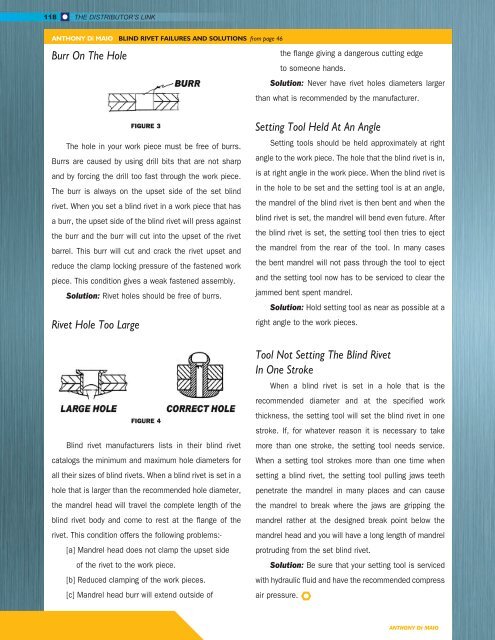WINTER 2017
Distributor's Link Magazine Winter Issue 2017 / Vol 40 No1
Distributor's Link Magazine Winter Issue 2017 / Vol 40 No1
You also want an ePaper? Increase the reach of your titles
YUMPU automatically turns print PDFs into web optimized ePapers that Google loves.
118<br />
THE DISTRIBUTOR’S LINK<br />
ANTHONY Di MAIO BLIND RIVET FAILURES AND SOLUTIONS from page 46<br />
Burr On The Hole<br />
the flange giving a dangerous cutting edge<br />
to someone hands.<br />
Solution: Never have rivet holes diameters larger<br />
than what is recommended by the manufacturer.<br />
The hole in your work piece must be free of burrs.<br />
Burrs are caused by using drill bits that are not sharp<br />
and by forcing the drill too fast through the work piece.<br />
The burr is always on the upset side of the set blind<br />
rivet. When you set a blind rivet in a work piece that has<br />
a burr, the upset side of the blind rivet will press against<br />
the burr and the burr will cut into the upset of the rivet<br />
barrel. This burr will cut and crack the rivet upset and<br />
reduce the clamp locking pressure of the fastened work<br />
piece. This condition gives a weak fastened assembly.<br />
Solution: Rivet holes should be free of burrs.<br />
Rivet Hole Too Large<br />
FIGURE 3<br />
FIGURE 4<br />
Blind rivet manufacturers lists in their blind rivet<br />
catalogs the minimum and maximum hole diameters for<br />
all their sizes of blind rivets. When a blind rivet is set in a<br />
hole that is larger than the recommended hole diameter,<br />
the mandrel head will travel the complete length of the<br />
blind rivet body and come to rest at the flange of the<br />
rivet. This condition offers the following problems:-<br />
[a] Mandrel head does not clamp the upset side<br />
of the rivet to the work piece.<br />
[b] Reduced clamping of the work pieces.<br />
[c] Mandrel head burr will extend outside of<br />
Setting Tool Held At An Angle<br />
Setting tools should be held approximately at right<br />
angle to the work piece. The hole that the blind rivet is in,<br />
is at right angle in the work piece. When the blind rivet is<br />
in the hole to be set and the setting tool is at an angle,<br />
the mandrel of the blind rivet is then bent and when the<br />
blind rivet is set, the mandrel will bend even future. After<br />
the blind rivet is set, the setting tool then tries to eject<br />
the mandrel from the rear of the tool. In many cases<br />
the bent mandrel will not pass through the tool to eject<br />
and the setting tool now has to be serviced to clear the<br />
jammed bent spent mandrel.<br />
Solution: Hold setting tool as near as possible at a<br />
right angle to the work pieces.<br />
Tool Not Setting The Blind Rivet<br />
In One Stroke<br />
When a blind rivet is set in a hole that is the<br />
recommended diameter and at the specified work<br />
thickness, the setting tool will set the blind rivet in one<br />
stroke. If, for whatever reason it is necessary to take<br />
more than one stroke, the setting tool needs service.<br />
When a setting tool strokes more than one time when<br />
setting a blind rivet, the setting tool pulling jaws teeth<br />
penetrate the mandrel in many places and can cause<br />
the mandrel to break where the jaws are gripping the<br />
mandrel rather at the designed break point below the<br />
mandrel head and you will have a long length of mandrel<br />
protruding from the set blind rivet.<br />
Solution: Be sure that your setting tool is serviced<br />
with hydraulic fluid and have the recommended compress<br />
air pressure.<br />
ANTHONY Di MAIO

















